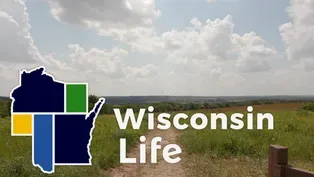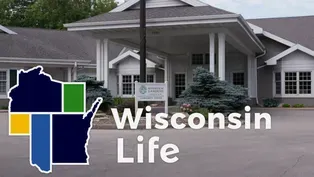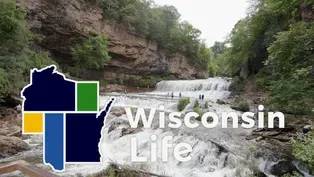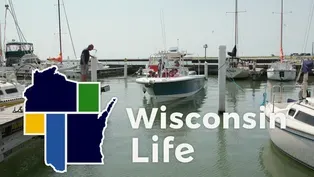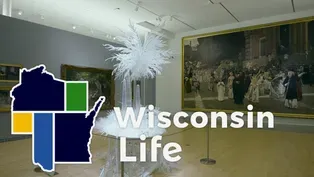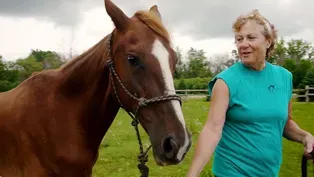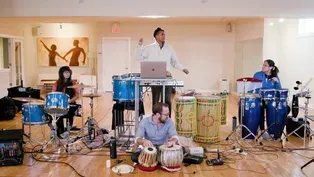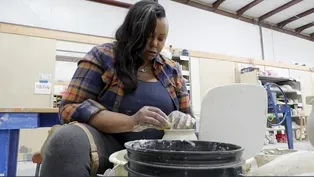
Wisconsin Great Northern Railroad in Trego
Season 10 Episode 6 | 26m 48sVideo has Closed Captions
All aboard the Wisconsin Great Northern Railroad for a historic ride in the Northwoods.
Hop aboard the Wisconsin Great Northern Railroad for a historic train ride through the Northwoods. The family-run business offers pizza, wine and dinner train trips year-round. We also meet the host of the 98.7FM WVMO radio program Bea’s Buzz, the founder of Elkhart Lake’s Amazing Grace Equine Sanctuary and a Madison pottery artist.
Problems with Closed Captions? Closed Captioning Feedback
Problems with Closed Captions? Closed Captioning Feedback
Wisconsin Life is a local public television program presented by PBS Wisconsin
Funding for Wisconsin Life is provided by the Wooden Nickel Fund, Mary and Lowell Peterson, A.C.V. and Mary Elston Family, Obrodovich Family Foundation, Stanley J. Cottrill Fund, Alliant Energy, UW...

Wisconsin Great Northern Railroad in Trego
Season 10 Episode 6 | 26m 48sVideo has Closed Captions
Hop aboard the Wisconsin Great Northern Railroad for a historic train ride through the Northwoods. The family-run business offers pizza, wine and dinner train trips year-round. We also meet the host of the 98.7FM WVMO radio program Bea’s Buzz, the founder of Elkhart Lake’s Amazing Grace Equine Sanctuary and a Madison pottery artist.
Problems with Closed Captions? Closed Captioning Feedback
How to Watch Wisconsin Life
Wisconsin Life is available to stream on pbs.org and the free PBS App, available on iPhone, Apple TV, Android TV, Android smartphones, Amazon Fire TV, Amazon Fire Tablet, Roku, Samsung Smart TV, and Vizio.
Providing Support for PBS.org
Learn Moreabout PBS online sponsorshipMore from This Collection
Blackhawk Ski Club in Middleton
Video has Closed Captions
We explore the competitive side of winter sports with the Blackhawk Ski Club in Middleton. (26m 48s)
Holi Festival of Colors in Wausau
Video has Closed Captions
We celebrate the Holi Festival of Colors at the Monk Botanical Gardens in Wausau. (26m 49s)
Retzer Nature Center in Waukesha
Video has Closed Captions
Angela visits the wild side of Waukesha at the Retzer Nature Center and planetarium. (26m 48s)
Video has Closed Captions
We tour Riverview Gardens in Appleton, a non-profit offering job training and employment. (26m 48s)
Willow River State Park in Hudson
Video has Closed Captions
Explore Willow River State Park’s stunning waterfall, serene lake and endless trails. (26m 48s)
Sailing Education Association of Sheboygan
Video has Closed Captions
We learn about adaptive sailing with SEAS, the Sailing Education Association of Sheboygan. (26m 48s)
Museum of Wisconsin Art in West Bend
Video has Closed Captions
Celebrate artists in our state at MOWA, Museum of Wisconsin Art in West Bend. (26m 49s)
Providing Support for PBS.org
Learn Moreabout PBS online sponsorship- Announcer: The following program is a PBS Wisconsin original production - Angela: Coming up on Wisconsin Life: - "VMO Show."
- An up-and-coming radio star... - The VMO show.
- The founder of a horse sanctuary, a mentorship program for young artists, a pair of scientists working towards a more inclusive future, and a potter throwing works of art.
That's all ahead on Wisconsin Life!
[uplifting guitars, strings, piano, and drums] - Announcer: Funding for Wisconsin Life is provided by Lowell and Mary Peterson, Alliant Energy, donors to the Focus Funds for Wisconsin Programs, and Friends of PBS Wisconsin.
- Welcome to Wisconsin Life.
[train horn toots] I'm your host, Angela Fitzgerald.
We're hopping on board the Wisconsin Great Northern Railroad for a historic train ride through the Northwoods.
The train leaves the depot here in Trego and travels a winding route with scenic views along the way.
[mellow guitar music] There are several train rides offered: the family pizza train, a relaxing dinner train, the overnight bed and breakfast, and more.
Visitors can also step back in time by visiting the ranch bar car built in the 1950s.
The Wisconsin Great Northern Railroad was started by husband-and-wife team, Greg and Mardell Vreeland.
[footsteps thud] They renovated each of the train cars into comfortable lounge areas, private dining rooms, and bedrooms.
It's a nostalgic ride offering something for everyone.
Before we fire up the engine and leave the station, let's flip the switch on our first story... [cymbals chiming] ...as we go live with a young radio star in Monona with a show that's the bee's knees.
[mellow guitar music] [lighthearted synth music] - Beatrix Pauli: I hope I make somebody's day better and give them something to listen to when they're bored.
I'm Beatrix-- I go by Bea-- and I make radio shows or podcasts.
Hi, I'm Bea, and welcome to "Bea's Buzz."
It's a very bee-filled show today.
I'll talk with Olivia of Honey Girl to hear all about raising bees right here in Monona.
First up, a song to get us moving and grooving.
[mellow groove music] - It's called "Bea's Buzz."
[mellow groove music] And it was kind of Dad's idea, kind of my idea.
I just thought it would be cute since I go by Bea.
Today, I'm here with Joe Martin of the "VMO Show."
Hi, Joe.
I think it was about 2017 when I first moved to Monona, which I didn't know it, but it was actually the first year that WVMO hit the airwaves.
I got to go to the radio station and record a PSA with my classmate.
And they asked me to come back and do a different PSA.
And then, I came up with a jingle.
And eventually, they were like, "Oh, hey, if Bea wants her own show, that'd be awesome."
And at first, we thought they were joking, but they weren't.
So, yeah, that's how "Bea's Buzz" was born.
I've been doing it for two-ish years.
So, I think we have 22 episodes roughly.
And I do book reviews.
I interview people.
I have a few questions for you.
How did you get involved with WVMO, and how long has the "VMO Show" been on the air?
- Joe Martin: Well, I first heard about VMO-- - Beatrix: And I share useless facts.
I also play music.
[Beatrix gasps] - Yes.
- Is it?
- Oh, my gosh!
So, my mom is kind of my... music producer.
So, she picks most of the songs; I pick a few.
Dad does pretty much all the heavy lifting.
I have to give him that credit.
He edits it.
- And then, I just eject it, right?
- And adds in all the special effects and cuts out the extra bits.
And then, I send the file to the radio station, and then they play it.
Hi, I'm Bea, and welcome to "Bea's Buzz."
Today, we have National Geographic explorer Dr. Rae Wynn-Grant, an inspiration to girls of color interested in careers like science and adventure.
Do you have advice for kids who want to be a National Geographic Explorer?
- Dr. Rae Wynn-Grant: I do, yeah, I do have advice.
- I definitely think I've improved since my first one.
I mean, I'm not gonna be like, "Listen to my show or else!"
[laughs] But if you can find the time to listen to my show, that'd be awesome.
That brings us to the end of another "Bea's Buzz" on WVMO, the coolest little station in the nation!
Have a great day, Monona!
[mellow piano music] Mic drop.
[mic thuds] [people laughing] [shimmery music] - Angela: Next, we ride off to Elkhart Lake, where the founder of a sanctuary cares for gentle giants.
[soothing guitar strumming] - Erin Kelley Groth: One day, on my way to work, I saw these two horses.
It was the middle of winter, and they were up against this barn, and they were really, really skinny.
I was, like, freaking out.
So I called the Sheriff's Department.
And they came, they said, "We'll take care of this."
And the next day, they were gone.
So, that was like one of my first hints or clues.
It was like, this is what I'm supposed to do.
I'm supposed to help these animals that don't have voices.
[mellow guitar music] My name is Erin Kelley Groth.
I am executive director of Amazing Grace Equine Sanctuary.
[horse snorts] I kind of do a little of everything imaginable and even things you can't imagine.
[engine chugging] [hay rustling] [saw humming] [hammer banging] [drill whirring] [mellow guitar music] I would say our grain bill is probably close to $2,000 a month.
It's a lot of work.
[energetic guitar music] Mornings, you feed.
[gate clanking] You're feeding 20 animals.
Many of 'em are on specific diets.
[upbeat guitar music] You and or new volunteers are cleaning manure from the day before.
[upbeat guitar music] A very important aspect of this place is to keep it clean and to keep the horses healthy by keeping it clean.
[mellow ukulele music] It took many, many volunteers over the years to kind of accumulate and start the base and get that base growing that every day this place is clean from top to bottom.
[mellow ukulele music] [birds chirping] We have dozens of other volunteers.
Some come once a week; some come two times a week; some come every day.
But we can always count on a certain amount coming out every day.
[mellow ukulele music] They come from actually all around the state, Illinois, Iowa, Michigan, Minnesota, Midwest.
And people are searching for that beautiful spot of heaven for their horse to retire in, and it's like, yeah, there really isn't a place like that.
It's kind of a fairytale.
Good girl.
[mellow guitar music] Before I moved here, I had horses for 20 years, and I never heard of a blind horse.
I come here, for some reason, we have, you know, six, eight sometimes more, you know, one eye blind or both eyes blind.
[mellow guitar music] The horses were my place where I could relax, be myself.
They don't judge you.
They don't yell at you.
They just let you love on 'em.
[smacking lips] Good girl.
It's just kind of an indescribable thing.
[hair rustling] When you get hooked on it, you can't undo it.
You can't change it.
This is where I belong, you know.
This is where I feel alive.
[mellow guitar music] [shimmery music] - Angela: Now, we go to Madison to throw down with a potter who is crafting works of art out of clay.
[mellow guitar music] [mellow synth music] - Shandra Bjyrd: I find creating pottery really therapeutic.
I am able to get into a state where it's just pure creation.
"Flow" is how I've heard it described.
Being able to get to that spot is one of the best feelings in the world.
It's not only therapeutic, but also a big part of my identity, as well.
[mellow synth music] Hello, my name's Shandra Bjyrd.
I am the owner of Bjyrd Ceramics.
And I have been a potter for about 13 years.
[mellow synth music] I like to make forms with implied functions.
I like to make cups that look like they're cups, bowls that look like they're bowls.
I really do enjoy making things that people interact with every day.
[pottery wheel whirring] I'm not necessarily thinking about anything in particular.
I feel like my mind and my hands are just a lot more connected.
While I'm throwing, if I wanna augment or change that, by the time I'm thinking about it, my hands are already doing it.
So it's just a open and connectedness is what's going on up there.
[upbeat synth music] There's really no tool that sets you up to work with a wheel, and there's no medium that sets you up to work with clay.
They are their own standalone things.
So, everyone that comes to it is starting at base level.
For me, within the last couple of years, the surface design really comes after the item is made.
I don't have a glaze in mind, in general.
[liquid sloshing] Kind of leave that up for exploration.
[liquid sloshing] Yeah, that's great.
The ability to mold clay into something, and then fire it and have it be permanent is another thing that really drives me to working more with clay.
I've heard that once you fire something, you're in the fossil records for that area, and I think that's true.
I tell my students, especially when we're doing glazing, "Make sure that you're taking care for this.
It's only gonna last forever, that's all."
[Shandra laughs] [soothing synth music] The end goal is to be able to open up my own little studio at the edge of my property on a country road at the end of my driveway, and make pots, and do workshops, and mostly just create my own work.
Something that I can sell my pots at and provide some inspiration for folks who are interested.
Now that I've started selling my work and running into people who are like, "Oh, I got one of your pieces from my last show, and my dad loves it," or "I got it for myself, and it's my favorite cup," like, that's a great feeling.
Pottery is my purpose.
If ever there's something that I'm supposed to be doing here on Earth, that is it.
It's home, and it's definitely been a savior for me, as well.
This is more than an art form for me.
This is where I belong.
[soothing synth music] [shimmery music] - Angela: We're all aboard the Great Wisconsin Northern Railroad in Trego to discover more about this popular Northwoods adventure.
[groovy guitar music] It is full speed ahead as we hit the rails with co-founder and general manager Greg Vreeland.
- Greg Vreeland: The Wisconsin Great Northern Railroad is what is classified as a heritage railroad.
We utilize passenger cars and locomotives that are anywhere from 50 to 120 years old.
And we operate a variety of sightseeing-type excursions, dinner trains, family pizza train, and the country's only bed and breakfast train.
[groovy guitar music] The train goes through farm fields.
It goes through a deep woods and along the Namekagon River.
And the stretch of the Namekagon River that we go along is part of the National Park Service.
It's a stretch called the Wild River.
About 50 years ago, the government bought all of the private property and returned that stretch of river to wildlife.
My wife, Mardell, and I founded the railroad back in 1997, and we actually spent about five years prior to that building equipment.
And most of the equipment that we started with is kind of like a '57 Chevy that sat in a farmer's field for 30 years.
You know, totally dilapidated and run down, you know, rusty, windows broken out of it, that kind of thing.
And slowly, we rebuilt a number of cars, and then we started the railroad.
And we've been building ever since.
[groovy guitar music] - Today, the Wisconsin Great Northern Railroad runs a variety of trips, including one of their most popular, the pizza train.
- Thank you.
- Greg Vreeland: So, the family pizza train is one of our most popular trains.
And we operate that five days a week during the summer, and then, on weekends much of the rest of the year.
We're one of the-- probably the only railroad in the country that actually cooks the pizzas right on board the train.
- Angela: What's not to love about fresh pizza on a train?
- There's something about a train.
Kids are, you know, seemingly genetically programmed right from the beginning to love trains.
Just to see their expressions when they come out and actually get to go on the train and ride the train.
But the other thing is everybody you meet has a train story.
- Is this you all's first time on the train?
- Pat Smith: No.
- No.
- No?
- No, we've been riding it practically every year when we come up here.
- Oh, really?
Oh, wow.
So it's a family tradition to-- - Yes.
- Okay.
What's your favorite thing about this experience?
- Passenger: Just getting to ride a train, I think, you know.
The pizza.
- Uh-huh.
- Passenger: The views - Angela: They are, I know, they are beautiful.
It looks like we're getting some of it, but we haven't seen all of the views yet.
This is my first time, so.
- Oh.
No, well, you'll get to see the Namekagon eventually.
It runs right by it.
- Oh, very nice, okay.
- And you can see all the people out there canoeing and tubing.
- Beautiful.
- Passenger: That's the fun part of Wisconsin.
- Angela: And a fun time for all that hop aboard the Wisconsin Great Northern Railroad.
[shimmery music] Our next stop takes us to Madison, where a pair of scientists are promoting more inclusive practices in their work.
[mellow guitar music] [mellow orchestra music] - Ethan Parrish: Mostly, what I do in my own research is look at ancient lake and river systems.
So, I'm a geologist by trade, but I also am a filmmaker.
Visual media is a powerful tool of communicating science.
So, I think Dave saw one of my introductory educational geoscience videos.
And so the project kind of grew from there.
And ironically, as Dave and I were talking about this kind of educational style video, I was working on naming a river that existed about 50 to 60 million years ago in my own research and trying to name it and collaborating with the Eastern Shoshone Cultural Center.
I wasn't gonna do it because I was getting a lot of pushback from colleagues.
And then, as Dave and I talked about what he was trying to do, it kind of reinvigorated me to keep pushing for that.
And I learned a lot through that process, I think.
I ended up getting the river named in Shoshone called the Toya Puki River, which means "mountain fan," incorporating native groups not only from in the scientific process, but in the honorifics, in the what they get out of it, right, and honoring that they have something to bring to the table.
This is, you know, what Dave is doing here.
It's a fundamental addition and a fundamental practice in science writ large.
[air whooshing] - Dave Lovelace: So, one of the interesting things about paleontology, or really, any biological science is that we talk about different organisms.
And those organisms are like, you know, whatever it is that you're looking at.
Plants, it could be animals of various sorts.
All of these animals, all of these creatures that are alive, have a name.
When we're talking about these animals, these organisms, they're part of our world.
They're part of who we are.
And whether they're extinct or alive, they're still an integral piece of our history.
And I think names are pretty critical to how we think about and talk about them.
They have meaning.
I grew up in the sciences of vertebrate paleontology, and we learn all of these names.
And you might hear Tyrannosaurus rex, and it's a name that we all know and love and we've grown up with.
But where did that come from?
What does it mean?
I got into the science and started doing things, and found specimens and found animals that we needed to give names to.
And I realized that was a fun part of our job is I get to create a name.
And they get to be, oftentimes, it's something fun or meaningful to that person.
Historically, we've been naming things after folks.
We honor our ancestors in the sense of our academic ancestors.
Unfortunately, the thing is, is that process is laden with colonialism, with all sorts of historical artifacts that are not inclusive.
And names mean something, right?
And so, there's been an awakening, and certainly, for myself, it took a period of time to recognize that there isn't the inclusivity that we would want in the sciences.
And I don't think anybody's necessarily against it.
It's just that our tradition has always been we name it after folks; we name it after regions.
And those regions themselves hold colonial names.
And so, we have to be aware and be a little bit more understanding and thoughtful about how we go about naming things.
Names hold information themselves.
Brontosaurus, the thunder lizard, right?
Like, these names have some kind of cool, poetic thing, but you think about it.
Here's an animal.
It's like 20 tons walking around the Earth.
Of course, when it hits the ground, it's gonna make this thunderous sound.
Although if you've ever been in a zoo, elephants will tiptoe up and be, and, you know, they make soft sounds.
So thunder lizard, ironically, isn't actually a thunder lizard 'cause there's no way it was walking around with big thudding, you know, sounds in its feet.
But the name itself, right?
Thunder lizard, Brontosaurus, that means something.
But we'll add a name at the end of it.
The species name.
Often is something that is honoring a person, and we'll call these eponyms.
And we're really moving away from using names of people.
Really, we need to think about place.
Place becomes an important part of who we are, just like a name.
And so being able to honor a place or something that's a little bit more relevant.
But the names have meaning.
They attach something to an animal.
And I think it's a huge piece of how we communicate.
We're on the precipice, right, where we're sitting on this edge of recognition.
And the more we discuss it, the more we talk about it, I think, the more prevalent it will be in the sciences, in that folks will realize, like, "Yeah, this is probably a good idea.
"We need to change the way we're doing things.
And it starts now."
And it's really the generation coming up, I think, that's going to see the benefits of this.
And they will carry this on and actually bloom this into its full fruition.
[air whooshes] [shimmery music] - Angela: To wrap up, we meet a musician in Milwaukee running an organization elevating artists through mentorship.
[mellow guitar music] [dramatic synthesizer music] - Kiran Vedula: Music has always allowed me a way of meeting people.
It's always allowed me a way of having confidence in myself and helping people have joy.
[mellow synth music] My name is Kiran Vedula.
I'm a musician, producer, and educator based in Milwaukee, and I'm also the founder of Flutes at Dawn.
One, two, three, four.
[mellow groove music] We are a community-based performing arts nonprofit.
We're focused on music, dance, and digital media.
And the key word with Flutes at Dawn's mission is 'cross-cultural understanding.'
My show that's coming up, Hip-Hop DNA, is all about that.
♪ Too cold and that sucks, my bounce ♪ - Kiran Vedula: Hip-Hop DNA is a tribute to the music we call hip-hop.
And the music we call hip-hop is made up of drum breaks, samples, and this lineage of traditional rhythms that's now found its form in all these beats and everything.
[heels tapping] It's tracing those connections, and it's a tribute to the music as a whole and to the pioneers and the artists.
♪ I'm infinite ♪ - Kiran Vedula: I feel like Hip-Hop DNA is kind of like one of the flagships.
It's not just a show now.
It's almost like a brand and entity in and of itself.
[mellow percussive music] We were able to do 12 weeks of Hip-Hop DNA workshops over the summer.
And then, the most advanced students will actually get to be part of the performance, too.
♪ So next on the mic is, oh, my girl ♪ ♪ Come on, girl, sing that song ♪ - Kiran Vedula: Even when I first started working with kids, it wasn't my words or who I was.
It was the music that connected me to them.
♪ Whip your hair, whip your hair ♪ - I'm always looking up for someone to inspire me and help me, and I'm always looking down to somebody to mentor and help.
I think that's also part of my culture as an Indian, and literally, a boy like me, when I was nine or 10, I would actually go to live with my teacher, my guru, or my mentor.
I mean, you know, there's this whole process.
So, education and mentorship, I think, is just in my blood, too.
[upbeat percussive music] Welcome to the stage.
It's Brooklyn.
- Band: Woo - Brooklyn: ♪ And I said a hip-hop, hippity, hippity ♪ ♪ Let's hip hip-hop, you don't stop the rockin' ♪ - I've just had so much success with that and so much fulfillment.
And again, that youthful energy always feeds back into my music, too.
And it helps me stay young.
It helps me stay fresh without, you know, trying to be young myself.
[Kiran laughing] I guess I would answer the question, what does music mean to me, with the answer of, like, what has it done for me?
These songs are meditations for me to open my heart to get out of my own way.
Sometimes, I see people that I haven't seen in a while.
It's like, "Hey, man, you still doing music?"
I'm like, "I don't know what else I could ever do."
Like, I don't even know how to do anything else at this point.
♪ Living my life like it's golden, golden, golden ♪ - Luckily, music has led me to have all these other opportunities to speak in front of people, or write, or study in different ways, and teach, not only just being on stage.
So, it's just been beautiful backbone.
Thank you very much.
We'll see y'all again.
[audience clapping] [shimmery music] - So, we've come to the end of the line as we've traveled the Wisconsin Great Northern Railroad while sharing stories of people from around our state.
[upbeat synth music] To watch more, visit WisconsinLife.org.
Reach out to us by emailing Stories@WisconsinLife.org.
[upbeat synth music] Until we hit the tracks again, I'm your host, Angela Fitzgerald, and this is our Wisconsin Life.
Bye.
♪ ♪ [train horn blares] [mellow, soothing music] - Announcer: Funding for Wisconsin Life is provided by Lowell and Mary Peterson, Alliant Energy, donors to the Focus Fund for Wisconsin Programs, and Friends of PBS Wisconsin.
Video has Closed Captions
Amazing Grace offers a safe haven for unwanted, abused, or neglected horses. (3m 46s)
Video has Closed Captions
Beatrix Pauli, host of Bea’s Buzz radio show, is here to entertain the community. (3m 22s)
Video has Closed Captions
Two scientists work to decolonize their disciplines for a more inclusive future. (5m 37s)
Video has Closed Captions
Flutes at Dawn is a nonprofit focused on community education and cross-cultural unity. (3m 36s)
Video has Closed Captions
Shandra Bjyrd uses pottery as a form of expression and fulfillment. (3m 21s)
Providing Support for PBS.org
Learn Moreabout PBS online sponsorshipSupport for PBS provided by:
Wisconsin Life is a local public television program presented by PBS Wisconsin
Funding for Wisconsin Life is provided by the Wooden Nickel Fund, Mary and Lowell Peterson, A.C.V. and Mary Elston Family, Obrodovich Family Foundation, Stanley J. Cottrill Fund, Alliant Energy, UW...


